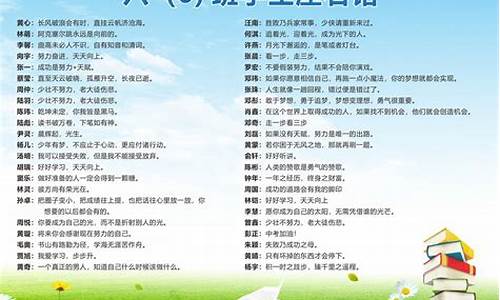您现在的位置是: 首页 > 经典语录 经典语录
英语句子结构的英文表达_句子结构英语七大结构英语单词
tamoadmin 2024-08-15 人已围观
简介1.英语 的句子结构。。详细一些2.求帮助英语1简单句、并列句、复合句根据语法形式,即句子的结构,英语的句子可分为简单句、并列句和复合句.1简单句句型:主语+谓语只包含一个主谓结构,而句子的各个结构都只由单词或短语表示.简单句有五种基本句型,详见第十七章.They are playing baseball in the garden.他们正在公园里打棒球.Her brother and siste
1.英语 的句子结构。。详细一些
2.求帮助英语

1简单句、并列句、复合句
根据语法形式,即句子的结构,英语的句子可分为简单句、并列句和复合句.
1简单句
句型:主语+谓语
只包含一个主谓结构,而句子的各个结构都只由单词或短语表示.简单句有五种基本句型,详见第十七章.
They are playing baseball in the garden.
他们正在公园里打棒球.
Her brother and sister both are teachers.
她的哥哥和姐姐都是老师.
2并列句
句型:简单句+并列连词+简单句
(常见的并列连词有and,but,or)
并列句是由两个或两个以上的简单句连接而成.并列句中的各简单句意义同等重要,相互之间没有从属关系,是平行并列的关系.它们之间用连词连结.
My friend was at home,and we talked for along time.
我的朋友在家,我们谈了好长时间.
英语 的句子结构。。详细一些
英语句子结构详解:
1.主语:可以作主语的成分有名词(如boy),主格代词(如you),数词,动词不定式,动名词等。主语一般在句首。
2.谓语:谓语由动词构成,是英语时态、语态变化的主角,一般在主语之后。
3.宾语:宾语位于及物动词之后,一般同主语构成一样,不同的是构成宾语的代词必须是‘代词宾格’
4.定语:定语是对名词或代词起修饰、限定作用的词、短语或句子定语通常位于被修饰的成分前。
5.状语:状语修饰动词、形容词、副词或全句,说明方式、因果、条件、时间、地点、让步、方向、程度、目的等状语在句子中的位置很灵活,常见情况为:通常在句子基本结构之后,强调时放在句首;修饰形容词或副词时,通常位于被修饰的词之前;表示时间、地点、目的的状语一般位于句子两头,强调时放在句首,地点状语一般须在时间状语之前;一些表示不确定时间(如:often)或程度(如:almost)的副词状语通常位于be动词、助动词、情态动词之后,动词之前。
英语句子结构分析方法:
1、简单句
简单句,即只有一个主谓结构的句子。除了特殊情况,英语句子中都有主语、谓语(或表语),有时候还有宾语;而且除了倒装句等特殊句型,一般情况下,主语、谓语、宾语的先后顺序是固定的,不可能宾语跑到谓语前面,或者谓语跑到主语前面。目前很多语法书都把英语的简单句归纳为五种基本句型。实际上,英语简单句还可以简化为三种形式:
主语 + 谓语(及物动词) + 宾语;I hate grammar.
主语 + 谓语(不及物动词); Grammar sucks.
主语 + 系动词 + 表语 Grammar is hell.
所以,我们在阅读句子的时候,不管句子有多长,不管是并列句还是复合句,都必须首先分清各句中的主语、谓语(或表语),有的句子中还包括宾语。因为主语、谓语、宾语中英语句子的主干,抓住了句子的主干,句子的基本意思就清楚了。
2、并列句
并列句就是两个或以上的简单句,由表示并列关系的连词或标点符号连接而成。常见的连词:and, not only...but also, neither...nor... or, either...or... otherwise,but, yet, while, so, for等。阅读中遇到并列关系的句子,一般情况下是以连词为界限,将句子分成前、后几个部分,并分别来分析,各句的意思一般可以单独理解,最后将各句合并即可。
3、 主从复合句
主从复合句即是复杂句,它也是由两个以上的句子构成。与并列不同的是,各分句之间的意思是紧密相连的,所以我们不能简单地把各个句子拆开来看,而必须将各分句综合起来进行理解。有时候,分句里面有可能还包含分句。
说到从句,我们还要介绍一下英语中的三大从句:名词性从句,形容词性从句和副词性从句。三大从句之下又包括纷繁复杂的从句形式:
名词性从句:主语从句,宾语从句,表语从句, 同位语从句
形容词性从句(定语从句):限制性,非限制性
副词性从句(状语从句):时间,地点,原因,条件,目的,让步,方式,结果
求帮助英语
.句子的成分:句子成分是句中起一定功用的一个组成部分。句子成分可以分为八种。 1)主语subject:主语是句子的主体,是句子所要说明的人或事物,表示句子描述的是“谁”或“什么”。主语通常由名词、代词、数词、动词不定式、动名词、或主语从句担任。 如:To become a professor has been his ambition.当教授一直是他的抱负。(不定式作主语) What we shall do next is not yet decided.下一步我们做什么还未定下来。(主语从句作主语) 2)谓语predicate:谓语是说明主语的动作或状态的部分。谓语一般由动词或动词短语担任,位置在主语之后。 如:His mother is a doctor.他的妈妈是大夫。(系动词) We should pay attention to English idioms.我们应注意英语(Q吧)的习语。(动词短语) 3)表语predicative:表语是在连系动词之后表示主语性质、特征、状态或身份的部分。表语通常由名词、代词、形容词、副词、介词短语以及动词不定式、动名词、分词或表语从句担任,位置在连系动词之后。 如:The football match is on.足球赛正在进行。(副词) All the pupils are on the playground.学生们现在都在操场上。(介词短语) He seemed surprised at the new.他对这消息似乎感到吃惊。(分词) The key question is how we should solve the problem.关键的问题是我们应该如何解决这个问题。(从句) 4)宾语object:宾语表示及物动词的对象或内容。介词后面的名词或代词叫做介词宾语。宾语通常由名词、代词、数词或与之相当的结构但任,位置在及物动词或介词之后。 如:Would you mind coming earlier tomorrow? 你明天早点来行吗?(动名词) I don’t know where he has gone.我不知道他去哪了.(从句) 5)补语complement:补语用于补充说明主语或宾语。补语通常由形容词、名词或其他相当的结构担任。补语分为宾语补足语和主语补足语。 宾语补足语: 如:The doctor advised her to stay in bed for a week.医生建议她卧床休息一周。(动词不定式) They saw her walking into the bookstore.他们看见她进了书店了。(分词) You should put your books in order.你应该把书摆整齐。(介词短语) 主语补足语:含有宾语补足语的句子改为被动语态时,原宾语和宾语补足语变为主语和主语补足语。 如:we found him working in the office.我们发现他正在办公室工作。 He was found working in the office.他被发现在办公室工作。(分词作主补) 6)定语attributive:定语用于限定或修饰名词或代词,通常由形容词或与之相当的结构担任。单词作定语一般放在被修饰语的前面,短语或从句作定语放在被修饰语的后面。 如:He is an honest boy.他是一个诚实的男孩。(形容词) The girl playing the violin is a freshman.拉小提琴的那个女孩是一年级学生。(分词短语) Those who want to go may go.想去的人都可以去。(从句) 7)状语adverbial:状语用于修饰动词、形容词、副词或整个句子。状语通常由副词或与之相当的结构担任。 如:He went to France to learn English.他去法国学英语。(不定式) He is leing for Shanghai the day after tomorrow.他后天动身去上海。(名词短语) 8)同位语ositive:同位语位于名词或名词性短语之后,说明其内容。同位语通常由名词、名词性短语或从句担任。 如:Then aroused the question where we were to get the machine needed.这时就产生了一个问题:我们到哪里去找需要的机器。(句子) The future belongs to you young people.未来是属于你们年轻人的。(名词) 2.英文句子构成:主语部分+谓语部分 英语中的句子有长有短,有简有繁,表面上看,似乎千变万化,但是从本质上来说,都可以把英语中的完整的句子分为两部分。即主语部分和谓语部分。主语部分以代词、名词或名词短语来充当,来表明我们要陈述的对象。而在主语之后的动词及其后面的部分,都是用来说明主语做什么,或者描述主语的状况。这就是陈述的内容,即谓语部分。 如:The moon rose slowly.月亮慢慢升起来了。 主语部分 谓语部分 He neither speaks English, nor understands it.他既不会讲英语,也听不懂英语。 主语 谓语部分 因此在写英文句子的时候,通常要有主语,还要写出谓语动词,既要有陈述对象,又要有陈述内容,这样才能表达一个完整的意思。 3.五种基本句型 1)主语+谓语动词(+状语) 此句型特点:既然该句型中动词后面没有宾语,所以用于这个句型的动词应该是不及物动词。 如:The sun rises and the sun sets.日升日落。 The fire is burning.火在燃烧。 The children are playing.小孩子正在玩耍。 这种句型的谓语动词后往往带有状语: 如:He works hard.他工作很勤奋。 The sun sets in the west.太阳从西面落下 2)主语+系动词+表语 所谓系动词,又叫连系动词。即这种动词并没有具体的动作,只是起连接主语和后边的成分的作用。 如:He looks unhy.他好像不高兴。 Bread is the staff of life.民以食为天。 Beauty is in the eye of the beholder.情人眼里出西施。 注:在英语中,除了be动词以外,还有以下系动词: a) 表示主语的特征、状态的:look, sound, taste, smell, seem, ear, feel等 如:The iron feels hot.这铁摸起来很烫 The rose doesn’t smell much.这玫瑰花闻起来不是很香。 b) 表示主语由一种状态转变为另一种状态的:become, grow, get, turn, go, fall, come等。(这些系动词和形容词连用,一般是句由固定的搭配关系) 如:Our supplies of sugar and rice fell short.我们的糖、米供应不足。 Hope your dreams will come true.希望你好梦成真。 The leaf will turn yellow in autumn.树叶秋天会变成**。 go hungry 挨饿 go sour变酸 go wrong出错 fall asleep睡着 fall due到期 c)表示主语保持某种状态的:continue, remain, stay, keep, hold, rest, prove等 如:The weather continued fine for several days.那几天,天气一直晴朗。 He held silent for the whole day.他一整天都沉默不语。 He has fallen into the habit of doing morning exercises to stay healthy.为了保持身体健康,他养成了晨练的习惯。 3)主语+谓语+宾语 英语(Q吧)中绝大多数的动词都适用于这一句型。 如:Beauty will buy no beef.漂亮不能当饭吃。 主谓宾 I he finished reading the book.我已经读完了这本书。 主谓宾 4)主语+谓语+双宾语 动词后面接两个宾语:一个指人的宾语,称之为间接宾语;另一个指物的宾语,称之为直接宾语。间接宾语和直接宾语统称为双宾语。 如:He showed the guard his passport.他把护照给门卫看。 主谓 间接宾语 直接宾语 I will buy you a meal. 主谓 间宾 直宾 根据间接宾语和直接宾语的关系,把动词分成三类: a)同give一样,当间接宾语后移时,间接宾语前需要带介词to,表示间接宾语是动作的接收者。这样的动词:bring, offer, pass, show, take, write等。 如:He showed the guard his passport. He showed his passport to the guard. b)同buy一样,当间接宾语后移时,间接宾语前需要带介词for,这样的动词有:book(预订), choose, find, get, keep, order, prepare等。 如:I am going to buy her a gift. I am going to buy a gift for her. c)有个别动词只用于这样的结构:“主语+动词+间接宾语+直接宾语”,不能用介词替换。这样的动词有:charge, cost, bet等。 如: I will bet you ten dollars.我跟你赌十块钱。 The repairman charged me ten dollars.修理工收了我十块钱。 5)主语+谓语+复合宾语 有些动词后面接宾语的时候意思不完整,因此在宾语后面还需要接补充说明宾语的补足语,宾语和宾语补足语统称为复合宾语。 常见的接复合宾语的动词有:oint, believe, choose, consider, elect, find, keep, let, make, suppose等。 如:They ointed John chairman.他们任命约翰为。 主谓宾 宾补 I believe him to be true.我相信他是诚实的。 主谓 宾语 宾补 注:如何区分双宾语和复合宾语 判断两种宾语的方法:在宾语后面加上be动词,若能构成完整的句子,则是补足语。 反之,则是直接宾语。 如:I made John our chairman.我选了约翰为我们的。 I made John a cake.我给约翰作了一块蛋糕。 我们可以说:John is our chairman.所以our chairman是宾语补足语。 我们不能说:John is a cake.所以 a cake是直接宾语。 4.句子的种类 见课本第132页-134页 2001年第40小题有对反意疑问句的考查 You never told us his telephone number, ____? A hadn’t you B didn’t you C had you D did you
希望纳
As soon as I arrived at the railway station, the train pulled into the railway station.
As soon as they reached the top of the mountain, it began to rain cats and dogs.
做这种题目要相信自己,加油!
下面的知识好好看看:
根据语法形式,即句子的结构,英语的句子可分为简单句、并列句和复合句。
1简单句
句型:主语+谓语
只包含一个主谓结构,而句子的各个结构都只由单词或短语表示
They are playing baseball in the garden.
他们正在公园里打棒球。
Her brother and sister both are teachers.
她的哥哥和姐姐都是老师。
2并列句
句型:简单句+并列连词+简单句(常见的并列连词有and,but,or)
并列句是由两个或两个以上的简单句连接而成。并列句中的各简单句意义同等重要,相互之间没有从属关系,是平行并列的关系。它们之间用连词连结。
Her father is a doctor and her mother is a teacher.
I liked the story very much but Li Ming wasn''t interested in it.
Hurry up,or you''ll be late.
3 复合句
句型:主句+连词+从句;或连词+从句+主句(包含一个主句、一个或一个以上的从句,或只包含一个从句,但有两个或两个以上的主句的句子叫复合句。)
复合句(The Complex Sentence):句子中有一个或一个以上的从句,叫做复合句。复合句可分为:
1).定语从句(The Attributive Clause);
2).状语从句(The Adverbial Clause);
3).名词性从句(The Noun Clause):
一、 定语从句
定语从句的定义定语从句在句子中作定语,用来修饰一个名词、名词词组或者代词。
先行词和引导词被修饰的名词、名词词组或代词叫做先行词;
在先行词和定语从句之间起连接作用的词叫做引导词。
引导词分为“关系代词”和“关系副词”。
关系代词和关系副词关系代词有:who, whom, whose, that, which, as。
关系副词有:when, where, why。 注意:关系副词里面没有how。
如果要修饰方式,用that或in which引导,或者不用引导词。
I don’t like the way (that, in which) he eyed me.
我不喜欢他看我的那个样子。
关系代词:who关系动词who在从句中主要作主语,在非正式语体里who还可以作从句中的宾语。
He is the man who wants to see you.
He is the man who I saw in the park yesterday.
关系代词:whomHe is the man (whom) I saw in the park yesterday.
(whom在从句中作宾语)
关系代词:whosewhose 用来指人或物,(只能用作定语, 若指物,它还可以同of which互换)。
They rushed over to help the man whose car had broken down.
Please pass me the book whose cover is green. (of which the cover/the cover of which)
关系代词:which(1)which指物,在从句中作主语或宾语,作宾语时在非正式语体中可以省略。
They needed a plant which didn't need as much water as rice.
The farm (which) we visited yesterday is located in the suburb of Beijing.
关系代词:which(2)当在which和that面前进行选择的情况下,一下情况要选which:
1.在非限制性定语从句中通常用which作引导词,而不能用that做非限制性定语从句的引导词。
2. 修饰整个主句。
I never met Julia again after that, which was a pity.
3. 修饰谓语部分。
He can swim in the river, which I cannot.
4. 介词 + which
They are all questions to which there are no answers.
关系代词:that(1)that多用来指物,有时也可以用来指人;在从句中作主语或宾语。指物的时候多用that,也可用which。
It’s a question that (which) needs careful consideration.
(指物,作主语。)
Who is the man that is reading a magazine under the tree?
(指人,作主语。)
The girl (that) we saw yesterday is Tom’s sister.
(指人,作宾语,可省略。)
关系代词:that(2)在以下的情况中,只能用that作引导词,而不能用which作引导词。
1. 先行词为all , everything, anything, nothing, little等不定代词时。
All (that) she lacked was training.
2. 先行词被形容词最高级修饰时
This is the best film that I he ever seen.
3. 先行词被序数词和the last修饰时
4. 先行词中既有人又有物时
They talked about the teachers and the schools that they had visited.
5. 主句是含有who或which的特殊疑问句,为了避免重复时
二、 状语从句
1 地点状语从句
地点状语从句通常由where, wherever 引导。
Where I live there are plenty of trees.
Wherever I am I will be thinking of you.
2 方式状语从句
方式状语从句通常由as, (just) as…so…, as if, as though引导。
1) as, (just) as…so…引导的方式状语从句通常位于主句后,但在(just) as…so…结构中位于句首,这时as从句带有比喻的含义,意思是"正如…","就像",多用于正式文体,例如:
Always do to the others as you would be done by.
你希望人家怎样待你,你就要怎样待人。
As water is to fish, so air is to man.
我们离不开空气,犹如鱼儿离不开水。
Just as we sweep our rooms, so we should sweep backward ideas from our minds.
正如打扫房屋一样,我们也要扫除我们头脑中落后的东西。
2) as if, as though
两者的意义和用法相同,引出的状语从句谓语多用虚拟语气,表示与事实相反,有时也用陈述语气,表示所说情况是事实或实现的可能性较大。汉译常作"仿佛……似的","好像……似的",例如:
They completely ignore these facts as if (as though) they never existed.
他们完全忽略了这些事实,就仿佛它不存在似的。(与事实相反,谓语用虚拟语气。)
He looks as if (as though) he had been hit by lighting.
他那样子就像被雷击了似的。(与事实相反,谓语用虚拟语气。)
It looks as if the weather may pick up very soon.
看来天气很快就会好起来。(实现的可能性较大,谓语用陈述语气。)
说明:as if / as though也可以引导一个分词短语、不定式短语或无动词短语,例如:
He stared at me as if seeing me for first time.
他目不转睛地看着我,就像第一次看见我似的。
He cleared his throat as if to say something.
他清了清嗓子,像要说什么似的。
3 原因状语从句
比较:because, since, as和for
1) because语势最强,用来说明人所不知的原因,回答why提出的问题。当原因是显而易见的或已为人们所知,就用as或 since。
I didn't go, because I was afraid.
Since /As the weather is so bad, we he to delay our journey.
2) 由because引导的从句如果放在句末,且前面有逗 号,则可以用for来代替。但如果不是说明直接原因,而是多种情况加以推断,就只能用for。
He is absent today, because / for he is ill.
He must be ill, for he is absent today.
4 目的状语从句
表示目的状语的从句可以由that, so that, in order that, in case等词引导,例如:
You must speak louder so that /in order that you can be heard by all.
Better take more clothes in case the weather is cold.
5 结果状语从句
结果状语从句常由so… that 或 such…that引导,掌握这两个句型,首先要了解so 和 such与其后的词的搭配规律。
比较:so和 such
其规律由so与such的不同词性决定。such 是形容词,修饰名词或名词词组,so 是副词,只能修饰形容词或副词。 so 还可与表示数量的形容词many, few, much, little连用,形成固定搭配。
so foolish such a fool
so nice a flower such a nice flower
so many / few flowers such nice flowers
so much / little money. such rapid progress
so many people such a lot of people
( so many 已成固定搭配,a lot of 虽相当于 many,但 a lot of 为名词性的,只能用such搭配。)
so…that与such…that之间的转换既为 so与such之间的转换。
The boy is so young that he can't go to school.
He is such a young boy that he can't go to school
6 条件状语从句
连接词主要有 if, unless, as/so long as, on condition that 等。.
if 引导的条件句有真实条件句和非真实条件句两种。非真实条件句已在虚拟语气中阐述。
unless = if not.
Let's go out for a walk unless you are too tired.
If you are not too tied, let's go out for a walk.
7 让步状语从句
though, although
注意: 当有though, although时,后面的从句不能有but,但是 though 和yet可连用
Although it's raining, they are still working in the field.
3) ever if, even though. 即使
We'll make a trip even though the weather is bad.
4) whether…or- 不管……都
Whether you believe it or not, it is true.
5) "no matter +疑问词" 或"疑问词+后缀ever"
No matter what hened, he would not mind.
Whatever hened, he would not mind.
替换:no matter what = whatever
no matter who = whoever
no matter when = whenever
no matter where = wherever
no matter which = whichever
no matter how = however
注意:no matter 不能引导主语从句和宾语从句。
(错)No matter what you say is of no use now.
(对)Whatever you say is of no use now.
你现在说什么也没用了。(Whatever you say是主语从句)
(错)Prisoners he to eat no matter what they're given,
(对)Prisoners he to eat whatever they're given. 囚犯们只能给什么吃什么。
8 比较while, when, as
1)as, when 引导短暂性动作的动词。
Just as / Just when / When I stopped my car, a man came up to me.
2)当从句的动作发生于主句动作之前,只能用when 引导这个从句,不可用as 或 while。
When you he finished your work, you may he a rest.
3)从句表示"随时间推移"连词能用as,不用when 或while。
As the day went on, the weather got worse.
日子一天天过去,天气越变越坏。
9 比较until和till
此两个连词意义相同。肯定形式表示的意思是"做某事直至某时",动词必须是延续性的。否定形式表达的意思是"直至某时才做某事"。动词为延续性或非延续性都可 以。 正确使用这两个连词的关键之一就在于判断句中的动词该用肯定式还是否定式。
肯定句:
I slept until midnight. 我一直睡到半夜时醒了。
Wait till I call you. 等着我叫你。
(在肯定句中可用before代替 Let's get in the wheat before the sun sets.)
否定句:
She didn't arrive until 6 o'clock.
Don't get off the bus until it has stopped.
1)Until可用于句首,而till通常不用于句首。
Until you told me, I had heard nothing of what hened.
直到你告诉我以前,出了什么事我一点也不知道。
2)Until when 疑问句中,until要放在句首。
---Until when are you staying? 你呆到什么时候?
--- Until next Monday. 呆到下周一。
注意:否定句可用另外两种句式表示。
(1)Not until …在句首,主句用倒装。
Not until the early years of the 19th century did man know what heat is.
直到19 世纪初,人类才知道热能是什么。
Not until I began to work did I realize how much time I had wasted.
直到我开始工作,我才认识到了我已蹉跎了几多岁月。
(2) It is not until… that…
10 表示"一…就…"的结构
hardly/scarcely…when/before, no sooner…than 和as soon as都可以表示"一…就…"的意思,例:
I had hardly / scarcely got home when it began to rain.
I had no sooner got home than it began to rain.
As soon as I got home, it began to rain.
注意:如果hardly, scarcely 或no sooner置于句首,句子必须用倒装结构:
Hardly / Scarcely had I got home when it began to rain.
No sooner had I got home than it began to rain.
三、 名词性从句
1).宾语从句(The Object Clause);
宾语从句在句子中起宾语作用的从句叫做宾语从句。宾语从句的引导词和主语从句的引导词相同。宾语从句可以作及物动词的宾语,作短语动词的宾语,介词的宾语。
宾语从句:及物动词Everybody knows that money doesn't grow on trees.
宾语从句:短语动词Please go and find out when the train will arrive.
宾语从句:介词的宾语I am interested in what she is doing.
宾语从句:否定的转移I don't suppose you're used to this diet.
我想你不习惯这种饮食。
I don't believe she'll arrive before 8.
我相信她8点之前不会到。
2).表语从句(The Predicative Clause);
表语从句在句子中起表语作用的从句叫做宾语从句。表语从句的引导词和主语从句的引导词相同。
What the police want to know is when you entered the room.
This is what we should do.
That's why I want you to work there.
as if, as though, because也可用来引导表语从句。
She seems as if she had done a great thing.
It is because you eat too much.
虚拟语气:表语从句主语是idea, notion, proposal, suggestion, request等名词时,作表语从句的动词为原形动词或should+原形动词。
My suggestion is that we (should) go and help him.
Our only request is that this should be settled as soon as possible.
3).同位语从句(The Appositive Clause)。
同位从句一般跟在某些名词如answer(答案),hope(希望),fact(事实),belief (信仰),news(消息),idea(主意;观念),promise(承诺),information(信息),conclusion(结论),order(命令), suggestion(建议),problem(问题),thought (想法)等后面。例如:I had no idea that you were here.
She told us her hope that she would become a pianist.
He made a promise that he would never come late.
同位语从句:whetherwhether可以引导同位语从句,而定语从句不能用whether作为引导词。
He hasn’t made the decision whether he will go there.
I he small dou whether he is suitable for the job.
同位语从句:whatwhat可以引导同位语从句,而定语从句不能用what作为引导词
I he no idea what he is doing now.
同位语从句:howhow可以引导同位语从句,而定语从句不能用how作为引导词
It’s a question how he did it.
同位语从句和定语从句的区别(1)同位语从句和先行词是同等的关系;而定语从句是用来修饰先行词,是从属的关系。
同位语从句和定语从句的区别(2)that在同位语从句中没有词义,不充当句子成分;而在定语从句中充当主语、宾语等句子成分。
同位语从句和定语从句的区别(3)whether, what, how可以用来引导同位语从句;而它们不能用来引导定语从句。









